The story behind „Music For Films“
In jenem legendären, einsamen Sommer (oder war es schon Herbst), in dem „Music For Films“ erschien, lebte ich in einer leergeräumten Wohnung, in der die Schatten einer alten Liebe noch an der Wand tanzten. Allmonatlich kaufte ich die „Sounds“, die beste Musikzeitschrift der alten Bundesrepublik. Ich stöberte durch die jüngste Ausgabe, als mein Blick auf eine kleine Werbung der Firma Polydor fiel: „Der Mann im Hintergrund“, war da zu lesen, so flüstert es mir meine Erinnerung ein, ein monochromes graues Cover war abgebildet – Music for Films wurde mit kalkuliertem Understatement verkündet. Sofort bestellte ich die Platte bei einem meiner zwei Dealer, in Unterlüss. Der andere Postversand war Jazz by Post in der Gleichmannstrasse 10 in Pasing, von dort kamen mir über Jahre u. a. viele ECM-Neuheiten ins Haus, die Schatztruhe der 70er Jahre war weit geöffnet. Unterlüss war für die Rockmusik und ihre Ränder zuständig. Zwei, drei Tage später hielt ich Music for Films in Händen. Und hörte sie zum ersten Mal.

Ich habe diese Platte mit ihren flüchtigen und mich auf jede Flucht mitnehmenden Skizzen, ihren vollkommenen Unfertigkeiten, ihren Sehnsuchts- und Angst- und Traumstoffen seither unendlich oft gehört, bewusst, unbewusst, im Hintergrund, im Seitengrund, Im Vordergrund. Beim Wandern (mit Knopf im Ohr), beim Schreiben, beim Einschlafen, Wachwerden, in der Fremde. Und als Alternative für „die Zigarette danach“. Beim ersten Hören wusste ich damals schon, 1978, dass diese Musik lebensbegleitend sein würde. Sie wurde rasch auch eine Medizin, sie half mir, mit den nackten Schatten an der leeren Wand zu tanzen, statt sie zu verscheuchen.
Und als damals ein Riese mich aus dem Bett und meiner Wohnung im 7. Stock schleudern wollte, ich meinen Geist vergeblich mit Kakao zu beruhigen suchte, der Alptraum aber wiederkehrte, und ich mir einen heißen Grog machte mit dem guten alten Pott, mit dem Auto auf einen großen leeren Acker in der Nähe von Würzburg fuhr, dort den Sonnenaufgang erlebte und meine einzige tief anrührende Begegnung mit einer Kantate von Bach aus dem schräpigen Autoradio hatte, und hernach in die Alpdruckwohnung heimkehrte, legte ich Music for Films auf, und erlebte, wie sich die vollkommen irrationalen Glücksgefühle, die sich schon auf dem kühlen Morgenacker aufgetaucht waren, weiter ausbreiteten, und ich mich gar freute auf die nächste Begegnung mit dem Riesen.
(Wer ganz oben auf „The Story“ klickt, hört, was Brian Eno mir vor ein paar Jahren über „Music For Films“ erzählte, und wie eng die Musik mit den Aufnahmesessions von „Another Green World“ verknüpft war. Es ist ein Fakt, dass kein Album öfter in den Klanghorizonten von mir in all den Nächten zwischen 1990 und 2021 gespielt wurde als diese beiden. Es ist ein Fakt, dass ich in meinem Leben kein Album öfter gehört als diese beiden.)

„The passage of time
Is flicking dimly up on the screen
I can’t see the lines
I used to think i could read between
Perhaps my brains have turned to sand““Luminal“ & „Lateral“
„Lieben oder hassen?! Ich liebe die Musik von David Sylvian. Einige seiner Songs sind für mich zeitlose Klassiker. Mit Melanie Dalibert ist es allerdings ganz anders, die Musik überlebt bei mir keine Minuten. Wenn ich lese, was David Sylvian über seine Zusammenarbeit mit Melanie schreibt, ist meine Reaktion: Wieso höre ich das nicht? Bin ich zu sehr mit dem Virus Jazz infiziert, um von dieser Musik noch erreicht zu werden? Übrigens geht es mir mit Brian Eno und seiner Musik der letzten Jahre genauso. Dafür muss ich wohl im Seniorenheim leben.“ (radiohoerer henry)

Flowworker: ***** („Luminal“) & **** („Lateral“)Warum ich noch nicht über das Büchlein „What Art Does“ von Brian Eno und Bette A. geschrieben habe, ist rasch erzählt: ich bin allzu vertraut mit all den Gedanken über Kunst, Feelings, Surrender, Play, etc. die Brian in dieser „unfinished theory“ ausbreitet, nach seinem Anspruch so verständlich, dass es auch nicht auf den Kopf gefallene Teenager verstehen können, und herrlich bunt bebildert ist es zudem! Wäre ich Kunstlehrer, wäre das Stammlektüre in meinen Klassen. Ab und zu schmökere ich mit Vergnügen in dem Bändchen.
Viel lieber aber begegne ich der Kunst ohne Metaebene, lasse die Feelings durch mich hindurch strömen und rauschen, wenn ich „Luminal“ oder „Lateral“ auflege, Brian Enos famose neuen Alben mit Beatie Wolfe, und erlebe da, ungefiltert, Surrender, Play, etc., in allen Schattierungen zwischen dem Unerhörten und dem Unheimlichen, zwischen dem Fest und den Erschütterungen des Lebens. Denn all das dringt hier durch, und viel zu fesselnd, in diesen Wochen, um kluge Worte darüber verlieren zu wollen.
Das Erlebnis der Tiefe spielt sich stets im Zwischenraum von Sender und Empfänger ab, und hier, bei den elf Songs von „Luminal“ etwa, bringe ich es schlicht und ergreifend so auf den Punkt, dass mein mutmassliches Songalbum des Jahres 2025 mich so tief erwischt, berührt, umfängt, umgarnt, verführt, auf gut deutsch „haunted“, dass es seinen Platz findet neben meinen Songalben der letzten beiden Jahre von Beth Gibbons und P.J. Harvey. „Luminal“ ist ein Album, das Tore öffnet, tief taucht und, mich jedenfalls, auf seltsam diskrete Weise, mitreißt!
P.S. I never got an interview in the years of „virtual conversations“ (the artist in an empty room (no „Zoom“, no „phoner“) that was technically so perfect (the icing on the cake). And her answers: interesting from start to end and „to the point“! You can listen to her solo talk from Brian Eno’s studio in Notting Hill until the end of September HERE!
The penultimate playlist of KLANGHORIZONTE at Deutschlandfunk, May 29
In regards to „Luminal“, surely one the most beautiful, haunting and seductive song albums of 2025, there is only one reason I don‘t come up with the minor quibble that Brian Eno isn‘t doing the lead vocals, and that is the voice of Beatie Wolfe! (Michael Engelbrecht, Deutschlandfunk, Klanghorizonte, May 29th, 2025)
Sequence matters. The first three albums all circling around a world disintegrating, in danger of falling apart. On his best album ever, William Tyler keeps an ear on remains of beauty. The last three albums deal with the heritage of Don Cherry. Thanks to Richard Williams reminding me of Mr. Cherry’s buried treasure. Two „far out fusion“-albums from the first half of the 70‘s are framing the central „Brian-and-Beatie“-passage of „dream and space music“. (By the way, Beatie Wolfe has written the lyrics and sings on „Luminal“, and she has a way with words, believe me! Brian Eno does the background vocals on every song. In addition, both play all kinds of instruments.) That it will finally happen this way, depends on three interviews (in preparation). I hope it will be time enough left for the „surprise track“ that stands apart of all topics mentioned above!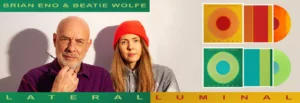
01 William Tyler: Time Indefinite
02 Eiko Isibashi: Antigone
03 Bennie Maupin: The Jewel In The Lotus (1974)
04 Beatie Wolfe & Brian Eno: Breath March, from: Luminal
05 Beatie Wolfe & Brian Eno: Lateral (excerpt)
06 Beatie Wolfe & Brian Eno: Play On, from: Luminal
07 Don Cherry: The Relativity Suite (1971)*
08 Angel Bat Dawid & Naima Nefertari: Journey to Nabta Playa
09 Natural Information Society and Bitchin Bajas: Totality10 Coda: Surprise Track
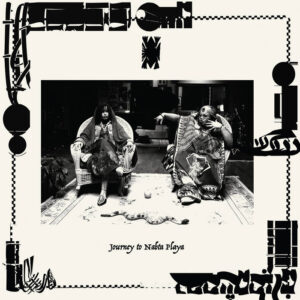
* „Wherever, whenever and by whomsoever the idea of “world music” was invented, it had no finer exponent, explorer and exemplar than Don Cherry. In a few months’ time it will be 30 years since Cherry died in Malaga of liver cancer, aged 58, leaving a world in which he was, to quote Steve Lake’s happy phrase, “a trumpet-playing lyric poet of the open road, whose very life was a free-flowing improvisation.” I suppose it was fitting that he should have died in Andalucia, a region where many cultural influences met in the Middle Ages to create a foundation of song.“ (Richard Williams, The Blue Moment)
More songs about space flights and bus rides (echoes on Eno‘s second lecture)
Music For Airports 2/1
Apollo: Deep Blue Day
My Life In The Bush Of Ghosts: Moonlight In Glory
Cale / Eno: Cordoba
„The Elderly Brothers“: Cerulean BlueI know the stories how Discreet Music and Music for Airports grew out of special experiences of Brian, in the studio experimenting with tape speed and synchronisation – and on a freshly built airport on Cologne. By the way, I never stooped returbing to these two albums. But the big fun of the second lecture was what I didn‘t know. Here are some of these moments including some aspects of the song CORDOBA. Please listen to this one before continuing reading. What kinds of feelings you have when listening to Cordoba? This photo was taken at Bundeskunsthalle, Bonn, August 1998, during my public talk with Brian. As you see, we sat quite relaxed there: this was the part with long drinks under an umbrella, and sharing our thoughts on some pieces we had brought along. Brian started with The Supremes.
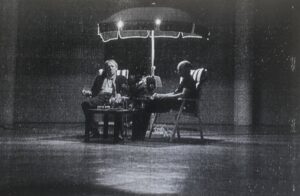
- One morning Brian was sitting in that new airport KÖLN / BONN the father of Florian from Kraftwerk once had built. Everything was impressive, the newness of every single element, the sunlight floating the spaces. But that German disco music?! In that space Brian found it slightly unnerving. He went to the bar, and asking for the music, someone told him something like this: „Oh, das ist unser Hans. Der bringt uns seine Kassetten von zuhause mit und dreht auf.“ Maybe, without Hans and his tape of German Disco Music (whatever that exactly was), Brian might never have composed Music For Airports. Sitting there, slightly impressed at first, then slightly bored by the music, he though about what kind od sounds he would want to listen to on airports. Music that should you make care less about your ego, your fears…. Thank you, Hans!
- The time of John and Brian working on the album „Wrong Way Up“ was not easy. The thing with the lyrics, not easy, too. In a corner of the studio Brian read a book titled something like „Learning Spanish in 30 Days“. He found a list of phrases. They started to combine the phrases. Small changes. Repetitions. I always liked the song (as I liked the while album), for me the song with Cale‘s softly sung/spoken sentences had quite a dreamy atmosphere. Listen to it again, dear reader…. Now with the lyrics in comment 3. And afterwards, taken from the lyric pages of Tom Boon‘s Eno web, a bit of background of the song that fits very well to what Brian told yesterday (comment 4).
- Brian shows how Deep Blue Day from Apollo grew from an improvisation on an omnichord. It finally got its special magic by slowing down the original tempo.
- Though the homework is connected to the Cordoba piece and some other backgrounds, the lecture focussed on the stories behind some ambient classics. Of course Brian tried to find ways to find a fusion songs and ambient music: the most radical examples for a melange between these two worlds, are the albums THE SHIP and FOREVERANDEVERNOMORE. In facts, ANOTHER GREEN WORLD, released on November, 14, 1974, was, with its many instrumental pieces, the first attempt to combine, intertwine both of these „worlds“.
- There is no replacement for listening. After the letcure, I am now in the mood to put on „Wrong Way Up“. Many years after the release of „Wrong Way Up“, Pitchfork publishes a long essay on the album that is worth reading: HERE.
- My second interview with Brian (published in Jazzthetik in 1990) was (one half) about some of the songs. Here some things he said on the song „Empty Frame“ that ring a bell in regards to Brian‘s recurring thoughts about surrender: „So, all of those images of power beyond your own conciousness, beyond your own will, and of separation, are to do with the sea image for me. The other thing that’s in there, is about a little ship that is always falling apart, that they always are trying to fix up again. It says in there „the broken sails“. This is also a very poignant image to me of the notion of people constantly trying to repair their sails. What do you have a sail for? To catch wind, to catch the other forces that are around, the controllable forces. The wind is the force that you can do something about. The sea is not, you know. But of course, the wind also keeps breaking your sails, so you always have to sow them back together again. It’s an endless struggle to try to keep going in any kind of a line. Because the other implication in this kind of song is „Why don’t you surrender? Why don’t you surrender to the tide and see where you go?“ And in one of my old songs „Julie with…“, that’s what happened in that song, the people have surrendered. They’ve stopped, they’ve stopped rowing the boat and they suddenly have allowed themselves to become completely, not victims exactly, but to have fallen under the control of this powerful force.“
- Time maybe to listen to that „blue piece“ of „The Elderly Brothers“ on the tracklist.
- One morning Brian was sitting in that new airport KÖLN / BONN the father of Florian from Kraftwerk once had built. Everything was impressive, the newness of every single element, the sunlight floating the spaces. But that German disco music?! In that space Brian found it slightly unnerving. He went to the bar, and asking for the music, someone told him something like this: „Oh, das ist unser Hans. Der bringt uns seine Kassetten von zuhause mit und dreht auf.“ Maybe, without Hans and his tape of German Disco Music (whatever that exactly was), Brian might never have composed Music For Airports. Sitting there, slightly impressed at first, then slightly bored by the music, he though about what kind od sounds he would want to listen to on airports. Music that should you make care less about your ego, your fears…. Thank you, Hans!
Creating a song in a lucid dream
It happened in Berlin, years and years ago. 2017, I think. It was one of my most thrilling lucid dreams ever. Because of its final minutes in which i heard a brand new Brian Eno song, sung by Brian himself. Vintage Eno. This is no sci-fi story. If you do your little exercises, you can learn to realize during a dream that you are dreaming. You have to be highly motivated, too, then it will happen, sooner or later. It is a creative tool with a broad field of possibilities. It is NOT dangerous. It is NOT a drug-related experience. It is a gift of the creative mind, the unconscious. I learned all this in 1982 when reading a book by Prof. Paul Tholey. He was the pionieer of lucid dreaming in Germany. I met this handsome guy some years later when I led a lucid dream group.
This is for Brian Eno‘s webinar on songs. Or just for the back of his mind. I never told him about this before. But he will very well remember we once sat in park near his London house quite early in the 90‘s („The Shutov Assembly“ was slowly growing), and I told him about the scientific research on lucid dreaming. The basics. His old friend Jon Hassell once opened a gate to this territory on his fantastic album „Dream Theory in Malaya“. Jon wrote some lines about special dream rituals of the Senoi, an old tribe. Lucid dreaming goes back, too, to ancient yoga traditions in which you can learn to go directly into the lucid dream state in the minutes you start sleeping. The scientific research began, no wonder, in Palo Alto, California, in the „wild 60‘s.“ Times of endless curiosity, that pervaded and inspired science, music, everything.
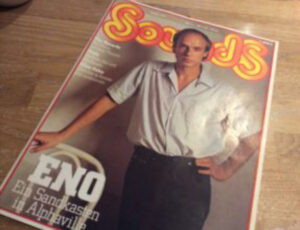
What happened on the day before this dream? I was at a concert of The Flaming Lips. I was in a second hand record store, too, and found an old copy from the German music magazine SOUNDS. With Brian Eno on the cover. I knew it from my days in Würzburg studying psychology and bought it with a nice rush of nostalgia. I remembered vividly on that day what he had told Lester Bangs. That, before the release of his song album „Bedore And After Science“, he had fragmented ideas for many, many songs. 80? 100? Keep that in mind, dear reader! And, by the way, I am not a musician at all and playing no instrument.The minutes before, I still felt my body in bed, then I was in the dream world. Conscious mind, sleeping brain. I was floating from the physical to the mental world. Old yoga style. I opened a door, closed my eyes and gave myself the impulse to float through the large glass window. The room looked like my living room. But I knew it was a simulation. I kept my eyes closed and wished I was flying into a warm summer’s day. I stretched my arms wide and rose into the air at a leisurely pace. When I opened my eyes, I was surprised because it felt like 22 degrees, but it was deep night on the edge of a forest.
I only flew for a short while, then I saw a suburban housing estate, which in retrospect reminded me of Weissdornweg in Dortmund, where I lived between the ages of five and ten. In my dream, I saw two or three lions (!) making their way towards me. I said to them: ‘Relax, lads. I’m on a peaceful mission.’ The lions slowed down and crouched down. (This part of the lucid dream, with the lions, is directly connected with the Senoi dream practice Jon Hassell once spoke about).
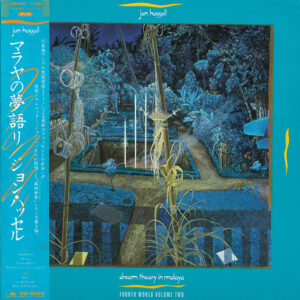
I entered a large house where a lot of young people were obviously gathered for a party. My dream self must have been around 18 and I thought it was time for an erotic adventure. So I called out to the crowd: ‘Where’s my old school sweetheart?’ Suddenly everyone present shouted in chorus: ‘Where’s my old school sweetheart? Where’s my old school sweetheart?’ The black-haired girl next to a music system was probably looking in my direction (I could only guess at her eyes because her fringes covered most of it), I went up to her and asked if I could kiss her. I could finally see her eyes, although they seemed a little asymmetrical. We hugged and kissed and I felt the beautiful beginning of a beautiful sensation.
I was absolutely delighted to realise that I was in a dream, held the girl’s hand and called out to the crowd: ‘There’s no music playing, I’d like to hear a new song by Brian Eno.’ I repeated the request inwardly to emphasise it, and suddenly Brian’s voice came out of the sound system, not particularly loud, but easy to hear. It was a melodic song with a gentle polyrhythm, stylistically from the Before and After Science period. An absolute feeling of happiness rushed through me, and I concentrated so much on the song that I forgot about my ‘old school sweetheart’, who didn’t look anything like my old school sweetheart, and concentrated fully on the music.
In the lucid dream, the critical consciousness is in full swing, and so I, the music journalist, was able to realise that the song is fantastic, that it is not a cover version of any other song, but ‘vintage Eno’ – except that Brian never recorded or composed this song. Maybe the song lasted three, four minutes. I was absolutely stunned. One of my favourite singers singing a new song in my lucid dream state! Afterwards, I had the feeling of being pulled back into my sleeping body. I really wanted to stay in the dream, but then, slowly, I woke up, the adventure was over. What a joy! And what a great song! It actually sounded, in regards to instrumental textures and the young voice, like a song from the era of „Before and After Science“! Imagine, we could record our dreams: how would royalties and copyrights have to be shared in this case?
– 40 – 43 –
40 – Harald Budd, Brian Eno – Ambient 2: The Plateaux Of Mirror
Obwohl ich schon immer viel instrumentale Musik gehört habe, war die Auswahl in dieser Serie bislang text- und stimmlastig. Es wurde gesungen oder gerappt. Da ich die Texte recht schnell schreibe, ist die Auswahl spontan: an einem anderen Tag hätte ich vielleicht etwas anderes ausgewählt. Es gibt sicher einige Alternative Versions, other possible music.
Seitdem ich so 35 bin, höre ich viel Musik beim Korrigieren von Arbeiten und Vorbereiten meines Unterrichts. Da bietet sich instrumentale Musik an. Das hat vielleicht auch eine Eigendynamik angenommen. Nicht nur deswegen folgt ab jetzt nur noch Instrumentalmusik (sorry, Beth).
Ich beginne ab 2010 damit, versuchsweise Klassik und Neo-Klassik zu hören: Streichquartette, Nils Frahm, Lubomyr Melnyk. Das ist alles schön, aber nicht ganz was ich suche.
Und irgendwann frage ich mich, ob nicht Brian Eno die Ambient Musik erfunden hat, um die Stimmung in einem Raum zu verändern, ohne sich all zu sehr aufzudrängen. Ich lade mir also erst „Ambient 1“ und recht schnell auch noch „Plateaux of Mirror“ runter (in der Zeit höre ich hauptsächlich Downloads über eine Soundbar von Teufel). Speziell das zweite Album hat einen unglaubliche Wirkung, ich bin hochaufmerksam am Hören und tief versunken in der Arbeit – ein merkwürdiger Effekt.
43 – Masayoshi Fujita – Apologues
Apologues hat einen besonderen Stellenwert und bekommt deswegen hier auch eine gesonderte Erwähnung: es war mit Abstand das meist gehörte Album in meiner iTunes Bibliothek, deren Top Ten zu 80% aus den Stücken dieses Albums bestand. Ich glaube, ich habe es um die 120mal gehört.
Ein Zwischenschritt also, bestimmt würde ich beim längeren Nachforschen noch mehr Alben finden, die einen besonderen Stellenwert haben. Urlaubsmusik, so etwas.
2016 absolviere ich eine Prüfung zum Heilpraktiker für Psychotherapie. Ich bin mir nicht sicher, wie viele Mitlesende diesen Schein kennen. Es ist eine relativ anspruchsvolle Prüfung, in der mündlich wie schriftlich das medizinische Wissen zu Psychiatrie, Psychosomatik und Psychotherapie abgefragt wird; die Durchfallquote liegt bei über 50%.
Ich bereite mich in einem einjährigen Kurs vor (an einem Abend in der Woche), nach einem halben Jahr treffe ich mich regelmäßig mit einer Lerngruppe. Nebenher arbeite ich und stemme den Alltag mit den beiden Kindern (meine Frau arbeitet in der Zeit extrem viel). Unmittelbar vor den beiden Prüfungen bin ich außerdem privat und/oder beruflich sehr eingebunden – die Termine liegen suboptimal.
Irgendwann gewöhne ich mir an, beim Lernen immer die fluffig verträumte Musik von Masayoshi Fujita laufen zu lassen, in der Hoffnung, dass es irgendetwas bringt. Auf den Zugfahrten nach Celle bzw. Lüneburg zu den beiden Prüfungen läuft „Apologues“ auf dem iPod. Die schriftliche Prüfung bestehe ich sehr knapp (bei einem Fehler mehr wäre ich durchgefallen) und irgendwie mogel ich mich durch die die mündliche Prüfung, auch wenn mindestens eine der drei Prüfenden mich durchfallen lassen will. Diese 60 Minuten waren so lang wie ein Tag. Vielleicht hat die Musik meine neuronalen Netze wirklich so aktiviert, dass sie zum Bestehen einen kleinen Beitrag leisten konnte.
Redding Road, Dogwood Coffee Shop & a sunset in 1963
„jetzt tauchen die sichtbaren Teile / der Geschichte auf, eine Folge von flimmernden Resten, / die zum Wiedererkennen aufbewahrt / und hervorgeholt sind.“ Es gibt schon einiges zu entdecken, wenn man das Cover der neuen Pan American-LP, von beiden Seiten, auf sich wirken lässt. Obwohl es Americana Ambient ist, konnte ich, weil beides von den Rändern unserer Welt erzählt, an meinem Geburtstag dazu einen alten Gedichtband von Jürgen Becker hernehmen, um zwischen Worten und Klängen zu pendeln. Eine Zeitlinie zwischen 1970, 1980, und 2024. In den Sounds, in den Zeilen versank ich, abwechselnd in die Musik, die Wortbilder, zuweilen gleichzeitig in beides.
„Reverberations of Non-Stop Traffic on Redding Road“ heisst die Arbeit von Pan American & Kramer. Ob die beiliegenden Fotos uns Redding Road am Abend zeigen? Das Gesumm von „distant traffic“ scheint Eingang in eines der Stücke dieses allerfeinst gearbeiteten Albums gefunden zu haben. Here‘s one track: „The Miner’s Pale Child’“. The calming guitar drones and swelling tones paint a serene picture. Kramer calls this piece „a wordless love letter to WS Merwin, the great American poet of nature and peace – the great champion of the weightlessness of words.“ (Gestern schickte uns Steve Tibbetts einen Gruss, und ich habe gleich den Dogwood Coffee Shop gegoogelt, in dem er hockte. In St. Paul, MS. Vielleicht ist Redding Road gar nicht so weit entfernt.)
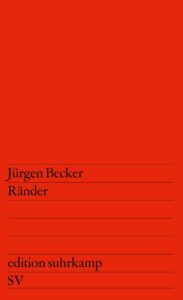
And so it happened I was dreaming about two imaginary albums within the last days: the next Brian Eno song album (his response from some days ago, on flowworker, made it sound a bit less imaginary). And then there’s the idea of an album by Marc Johnson and Steve Tibbetts, chants of sorts (a little more imaginary, but in autumn 2024 a matter of serious discussion, hopefully). A propos „imaginary“, „time lines“, & „memories“ Eine Deepl Überdetzung von Brians Lied „All I Remember“, kaum korrigiert, liest sich so: „Alles, woran ich mich erinnere, wenn ich mich sammle, ist / Ein einsames Feuerwerk, das über einem unergründlichen Meer aufblitzt / Ich versuche, mich an all die Schätze zu erinnern, die ich in jenen Tagen fand / Aber die Verbindung ist schwach / Und der Moment ist im Dunst verloren / Neue Gefühle zu spüren / Ketty Lester, Dee Clark, Bobby Vee / Über den Deich hinaus in die Dunkelheit / Wo der Fluss zum Meer wird / Flackern in Fenstern mit 40-Watt-Birnen und TV / Das Schwirren von Mücken auf einer Wiese, Sonnenuntergang 1963.“
Auch das wiederum handelt von den Rändern unserer Wahrnehmungswelten, wie einst, expressis verbis, ein Lyrikband des Altmeisters. Das Gedicht, dessen erste Zeilen ganz oben zu lesen sind, endet so: „Die Reihenfolge ist wieder ganz anders; / anfangen kann man mitten im Sommer, / unter Lautsprechern zwischen Bäumen.“ Wie geschehen einst auf einem Workshop mit Moebius und Harmonia, Musik von den üblichen Verdächtigen, nahe Forst im Weserbergland. Das ist eine andere Geschichte.
Nicht unter dreissig Seiten, so eine Nacherzählung. Und dann müsste alles fiktionalisiert werden, die Namen zumindest, und in kleinen Episoden, sollte es gut gemacht sein, ein Nachhall geschaffen werden. Tatsächlich ist die Weser kein gemächlicher Fluss, und es bedurfte schon kundiger Hilfe, die guten windgeschützten Orte für das Baden und die Boxen zu finden. Nirgends tauchen in Forst museale Zonen auf, von den Relikten aus alter Zeit ganz zu schweigen. Keine berühmten Sonnenschirme, nicht mal die Bäume vom Cover von „Sowiesoso“. Wir wären ja auch verrückt gewesen, Bäume zu suchen. Auch von dem berühmten Bordell im Wald, ein Edelkurtisanenbetrieb alter Schule, mit Stil, Klasse und exotischen Schönheiten, war Dorfältesten nicht mal ein „Es war einmal“ zu entlocken. Das halbe Dutzend der Einheimischen hatte die 80 satt überschritten, und war mehr im Vergessen als Erinnern angekommen. In einem anderen Dorf gab es eine gesicherte Feuerstelle, die keinen offenen Brand zuliess, und wir karrten die Scheite zusammen, stöpselten die Boxen ein, holten den Strom aus einem still gelegten Wirtshaus, und liessen uns von den beiden Harmonia-Platten umrauschen. Der Wein ging rum, das Haschisch, und alle schliefen im Umkreis von zwei Kilometern. Zuvor aber hielten uns das Feuer und die Dämmerung und die Musik gefangen, und jeder erzählte eine andere Story.